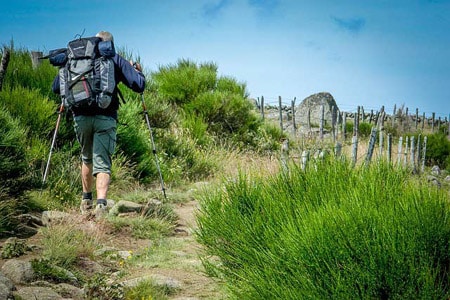This month, we take you on a walk along the paths of Compostela in the southern Landes and Basque country. Grab your stick, your credencial and your bag, and set off to discover the Voie Littorale, a historic route used by pilgrims for seven centuries.

In the shoes of a 13th-century pilgrim
Born and developed throughout the Middle Ages, the pilgrimage to Santiago de Compostela still attracts hundreds of thousands of pilgrims, walkers in search of spirituality and long-distance trekkers, both believers and non-believers. At the end of the road is the Cathedral of Santiago de Compostela in Spain, home to the tomb of Saint James the Greater, apostle of Christ and evangelizer of the Iberian Peninsula. In the 13th century, Santiago de Compostela became as important a pilgrimage destination as Rome and Jerusalem. Today, more than 300,000 people walk the Camino de Compostela every year.
The coastal road: 150 km from Sanguinet to Tarnos
The “Soulac”, “Littoral” or “English” route is a secondary itinerary of the pilgrimage to Santiago de Compostela. It begins in Soulac-sur-Mer and ends in Irun, Spain. In the Landes department, this path traced by faith follows the Côte d’ Argent for 150 km, from Sanguinet in the north to Tarnos in the south. In the Basque country, the coastal path passes through Bayonne, Saint-Jean-de-Luz and Hendaye, before plunging southwards towards Spain.
Ondres and Tarnos
Redeveloped in 2008, the Voie du Littoral crosses
the Seignanx
from north to south, following the Aquitaine coastline to Tarnos and its string of lakes. The route is well signposted and easily accessible from our
Landes campsite
. The trail passes through Ondres and Tarnos on centuries-old sacred paths.
In the early 16th century, the village of Ondres became an obligatory stopover on the pilgrimage to Compostela. Pilgrims leave the Bordeaux-Astorga route at Castets for the coastal road through Ondres and Tarnos, the last towns in the Landes region before the Basque Country. In Tarnos, the church of Saint Vincent is well worth a visit. Built in the 12th century and fortified in the 14th, it was part of a command-hospital of the Knights of the Order of St. John of Jerusalem.
Bayonne
Leaving Tarnos and the Landes coast, the Voie de Littoral heads straight for Bayonne. At the crossroads of the Soulac route and the Camino del Norte, the historic capital of the Basque Country was and remains an essential stopover for pilgrims. As early as the 12th century, pilgrims passing through the village would stop here and enjoy the hospitality and charity of the monks. A visit to Sainte-Marie Cathedral, a UNESCO World Heritage Site on the Pilgrim’s Way to Santiago de Compostela, is a must.
From here, you can continue along the coastal road, then cross the “Camino del Norte” (Northern Way) to reach the Santiago district in Irun, on the Spanish border. You can also take the Baztan route to Pamplona via the Camino francés, or follow the Nive route to Saint-Jean-Pied-de-Port and Roncesvalles, before crossing the Pyrenees.
Bidart
Bidart, the first village after Bayonne, is also well worth a visit. Its name comes from “bide artean”, meaning at the crossroads. Its 16th-century church houses a 12th-century wooden statue of Saint James in pilgrim’s garb. The building is surrounded by a cemetery, where numerous Basque discoidal steles stand. On the cliff facing the ocean, the Sainte-Madeleine chapel, dedicated to sailors, is a pleasant stopover for pilgrims, with a magnificent view over the ocean.
Saint-Jean-de-Luz
On the Basque coast Saint-Jean-de-Luz has always welcomed pilgrims. In the Middle Ages, monks offered hospitality to the faithful who came by way of the English. Take the opportunity to visit the Saint-Jean-Baptiste church, where the marriage of Louis XIV and the Infanta Maria Theresa of Spain took place on June 9, 1660. The stained-glass window in the south chapel represents Saint Jacques le Majeure, and bears witness to the city’s history of pilgrimage to Santiago de Compostela.
Hendaye
The last coastal town before Spain, Hendaye is the southernmost point on the coastal route to Santiago de Compostela cathedral. Before 1850, when the Saint-Jacques bridge was built, pilgrims had the choice of crossing the Bidassoa river by boat (for a toll), or crossing the border by making a detour via Béhobie.
